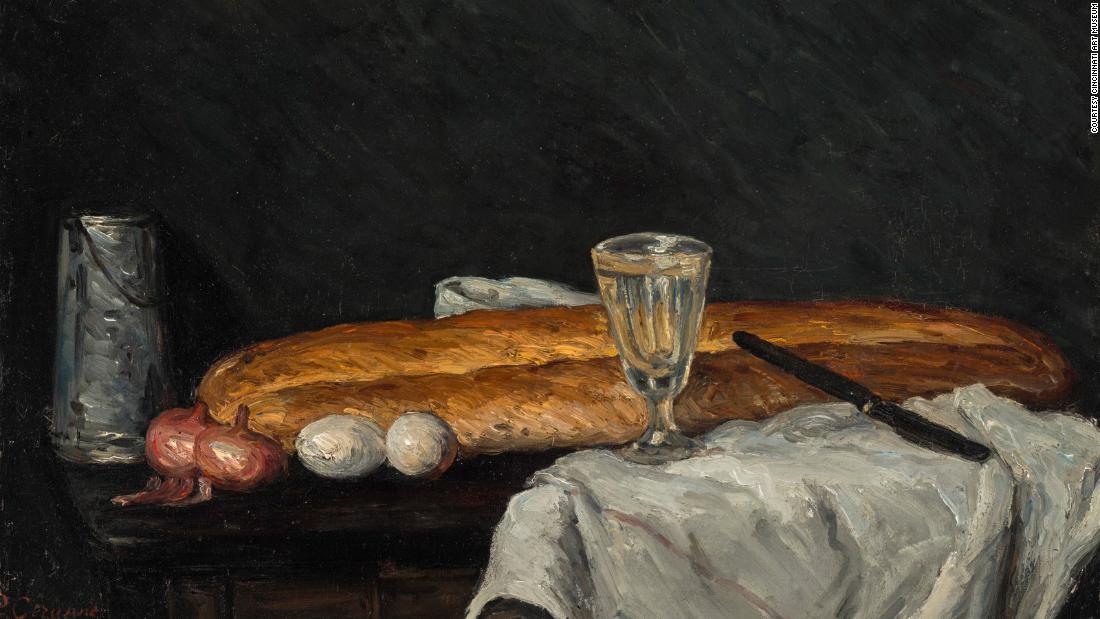Cincinnati Art Museum’s chief conservator Serena Urry was conducting a routine inspection of the institution’s prized Paul Cézanne painting “Still Life with Bread and Eggs” when she noticed something “odd.”
For an artwork dating back to 1865, the appearance of small cracks was no surprise. But they were concentrated in two specific areas, rather than distributed evenly across the canvas. What’s more, they revealed tiny flashes of white that stood out in contrast to the brooding palette of the French painter’s so-called “dark” period.
“I thought there might be something underneath that we should look at,” Urry said in a video interview.
The conservator asked a local medical company to bring a portable X-ray machine to the museum, where a technician scanned the 2.5-foot-wide oil painting in several parts. As Urry stitched the series of images together digitally using Photoshop, she saw “blotches of white” that indicated the presence of more white lead pigment.
“I was trying to figure out what the heck they were… then I just turned it (90 degrees),” she recalled. “I was all alone but I think I said ‘wow’ out loud.”
When the scan was rotated vertically, an image of a man emerged, his eyes, hairline and shoulders appearing as dark patches. Given the the figure’s body position, Urry and her museum colleagues believe it to be Cézanne himself.
Painted in 1865, Paul Cézanne’s “Still Life with Bread and Eggs” has been in the Cincinnati Art Museum’s collection for almost 70 years. Credit: Courtesy Cincinnati Art Museum
“I think everyone’s opinion is that it’s a self-portrait … He’s posed in the way a self-portrait would be: in other words, he’s looking at us, but his body is turned.
“If it were a portrait of someone other than himself, it would probably be full frontal,” she added.
Should that be the case, it would be among the earliest recorded depictions of the painter, who was in his mid-20s when the still life was completed. Cézanne is known to have produced more than two dozen self-portraits, though almost all of them were completed after the 1860s and were largely executed in pencil.
“We are at the outset of the process of discovering as much as we can about the portrait,'” said Peter Jonathan Bell, the museum’s curator of European paintings, sculpture and drawings, over email. “This will include collaborating with Cézanne experts around the world to identify the sitter, and undertaking further imaging and technical analysis to help us understand what the portrait would have looked like and how it was made.
“Stitched together, this information may add to our understanding of a formative moment in the early career of this great artist.”
Unanswered questions
Part of the Cincinnati Art Museum’s collection since 1955, “Still Life with Bread and Eggs” was painted in a realist style — inspired by the Spanish and Flemish Baroque periods — that Cézanne deployed early in his career. He later developed a more colorful aesthetic under the guidance of Impressionist painter Camille Pissarro, before spearheading the more structured style of the post-Impressionist movement.
In the mid-1860s, Cézanne was developing a new coarse painting technique, often using a palette knife to apply color. But whether his hidden portrait was an experiment gone wrong, or whether he simply reused an old canvas to save money, remains a matter of speculation.

The X-ray image shows the presence of white lead, which was used as a pigment. Credit: Courtesy Cincinnati Art Museum
Another possibility, Urry ventured, is that the painter suddenly felt inspired and “needed a canvas” — a theory supported by the fact that he appears not to have removed much paint before starting work.
“It’s pretty clear that he didn’t scrape it down,” Urry explained.
Many other questions remain, including the colors Cézanne used and how complete his original portrait was. Museum experts hope to analyze the painting using advanced scanning processes like multispectral imaging, which might reveal the underlying brushwork by assessing textures invisible to the human eye. X-ray fluorescence spectroscopy, meanwhile, could reveal which chemical elements are present and, thus, what colored pigments were used by the artist.
“We’re hoping to reach out to colleagues in the conservation and curatorial worlds to see if we can get access to other equipment,” said Urry.
For now, however, the museum is looking forward to putting “Still Life with Bread and Eggs” back on display. Since making the discovery in May, Urry has cleaned the painting and thinned the varnish on its surface. It returns to public view, alongside an image of the X-ray, from Dec. 20.
Further scans and analysis could entail transporting the artwork to another institution, presenting logistical challenges and meaning visitors to the museum might miss out on a chance to see one of only two — or arguably, now, three — Cézannes in its collection. “You can’t just pop it in your car and drive it to Chicago,” Urry said.
“The portrait has been there since he painted it, and it’s been there since (we acquired it in) 1955,” she added, “so there’s no rush.”
Sumber: www.cnn.com







